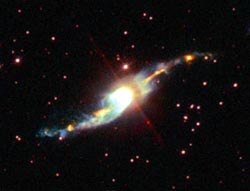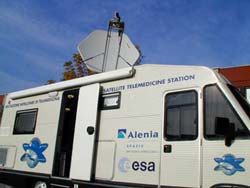
There are many mysterious objects seen in the night sky which are not really well understood. For example, astronomers are puzzled by the “jets” emerging from planetary nebulae. However, the S-shaped jet from Henize 3-1475 is the most perplexing of all.
“Jets” are long outflows of fast-moving gas found near many objects in the Universe, such as around young stars, or coming from black holes, neutron stars, and planetary nebulae, for example. The NASA/ESA Hubble Space Telescope has imaged th

ESA telemedicine technology enables specialist physicians to perform detailed patient consultations from hundreds of kilometres away.
High-resolution video images and data signals sent via satellite links have already made ’’teleconsulting’’ a routine procedure in one part of Europe. The Agency’’s involvement with satellite telemedicine began back in 1996, when ESA provided a satellite communication system to link Italian hospitals with a field hospital in Sarajevo in Bosnia, enablin

Feeding birds display similar habits to human consumers shopping for food, according to research published in the current edition of the Proceedings of the Royal Society.
A two-year study has discovered it is possible to influence hummingbirds’ choice of food by changing the options available to them, in the same way supermarkets can manipulate customers’ preferences by clever positioning of products.
The study is published in the current edition of Proceedings of the Royal Society

Scientists at The Scripps Research Institute (TSRI) have designed a new way to make vaccines against drugs of abuse that could become a valuable tool for treating addiction by helping the body clear the drug from the bloodstream.
The latest vaccine they created using this approach induces the body to clear nicotine.
“These new vaccines greatly suppress the reinforcing aspects of the drug,” says principal investigator Kim D. Janda, Ph.D. “Blocking it before it gets to the brain–th

U-M study finds no relationship between backpack use, pain
Backpacks have gotten a bad rap. For years, specialists have urged school children to lighten their loads, wear their backpacks on both shoulders and avoid lugging around those heavy school bags whenever possible.
But new research from a University of Michigan Health System physiatrist indicates backpacks don’t cause the stress and strain on young backs that they’ve been linked to.
“There is no go

A new antibiotic appears effective against deadly strains of tuberculosis resistant to nearly all currently available treatments for the infectious disease. The antibiotic, called linezolid, recently saved the lives of four women and one girl who were gravely ill with multidrug-resistant tuberculosis and who were hospitalized at Bellevue Hospital in New York City, according to a report by physicians at NYU School of Medicine. The patients, ranging in age from 10 to 54, were resistant to at least eigh

– new calculation confirms standard model of particle physics. Contribution of hadronic vacuum polarization determined with unprecedented accuracy. The magnetic moment of the muon is an important precision parameter for…
Technique may prevent formation of unwanted waves that siphon off needed energy. Heating plasma to the ultra-high temperatures needed for fusion reactions requires more than turning the dial on a…

An international team of astronomers, led by researchers from the Astronomical Observatory of the University of Warsaw, have identified a new class of cosmic X-ray sources. The findings have been…

Antibody that Neutralizes Inhibitory Factors Involved in Nerve Regeneration Leads to Enhanced Motor Function after Acute Spinal Cord Injury. Researchers at 13 clinics in Germany, Switzerland, the Czech Republic and…

How the body’s natural killer cells could fight leukemia. Every year, some 13,000 people in Germany are diagnosed with leukemia. Despite intensive chemotherapy, around one in two of them die….

… eco-friendly reactor converts air and water into ammonia. Producing enough ammonia to feed the world comes with a large carbon footprint;. process described in new UB-led study could help…

How simulations help manufacturing of modern displays. Modern materials must be recyclable and sustainable. Consumer electronics is no exception, with organic light-emitting diodes (OLEDs) taking over modern televisions and portable…

“Neurons that fire together, wire together” describes the neural plasticity seen in human brains, but neurons grown in a dish don’t seem to follow these rules. Neurons that are cultured…

The quest for sustainable energy solutions has been a major focus of scientific research for decades. Solar energy, a clean and renewable source, has emerged as a promising alternative to…

With a processing speed a billion times faster than nature, chip-based laser neuron could help advance AI tasks such as pattern recognition and sequence prediction. Researchers have developed a laser-based…

New technology could remotely identify various types of plastics, offering a valuable tool for future monitoring and analysis of oceanic plastic pollution. Researchers have developed a new hyperspectral Raman imaging…

Artificial Intelligence (AI) has established a strong presence across industries, large and small. The “VoBaKI” research project has empowered small and medium-sized enterprises (SMEs) with an innovative tool to independently…